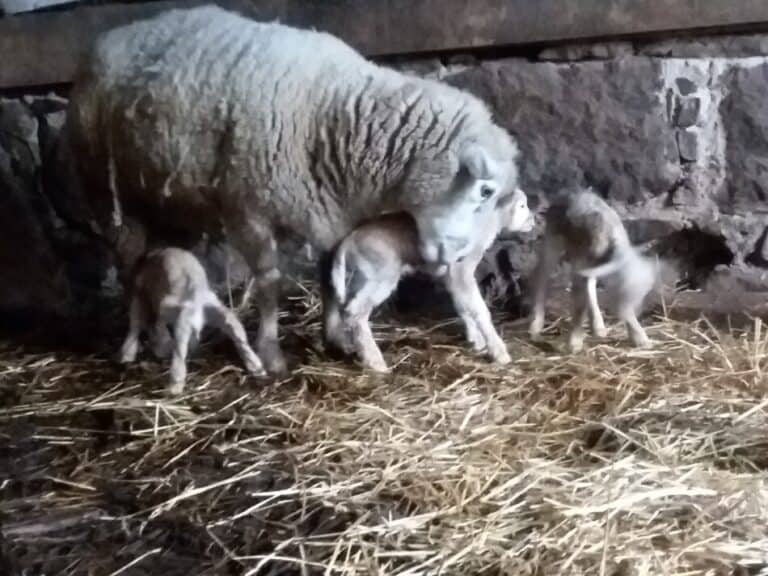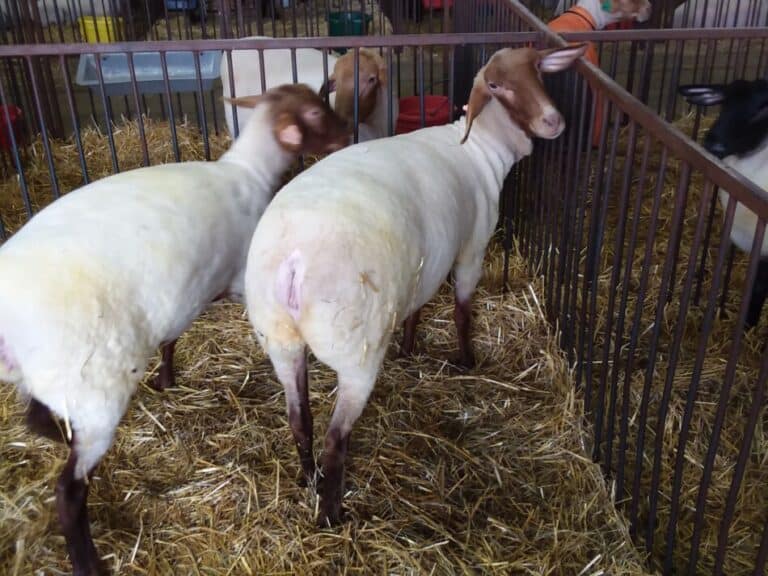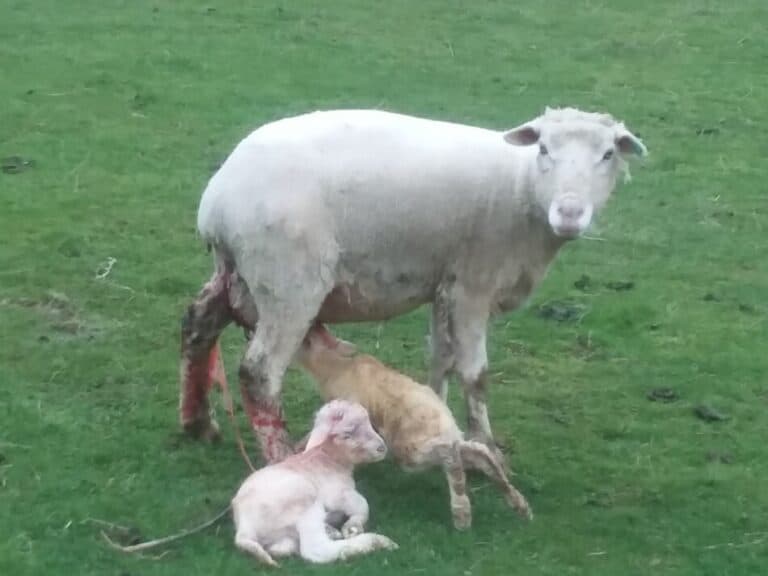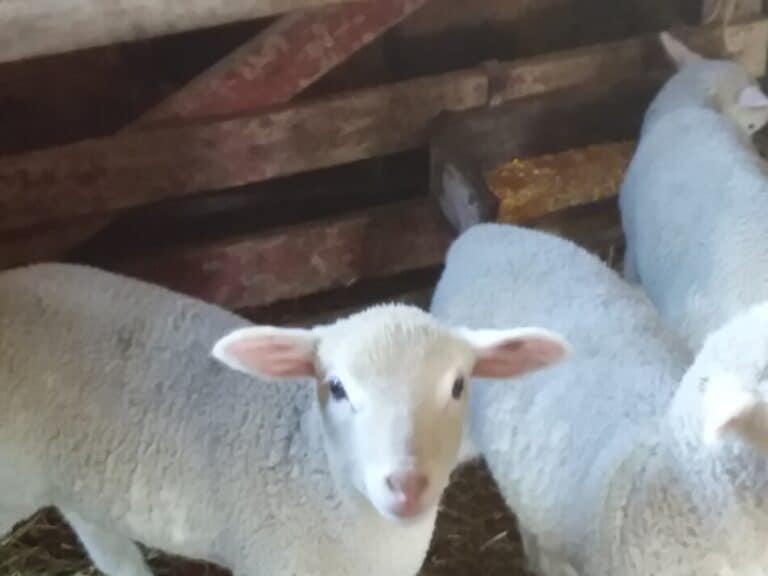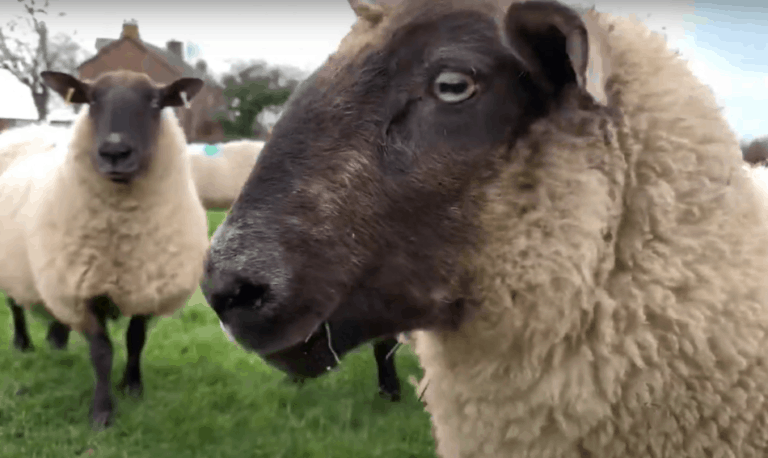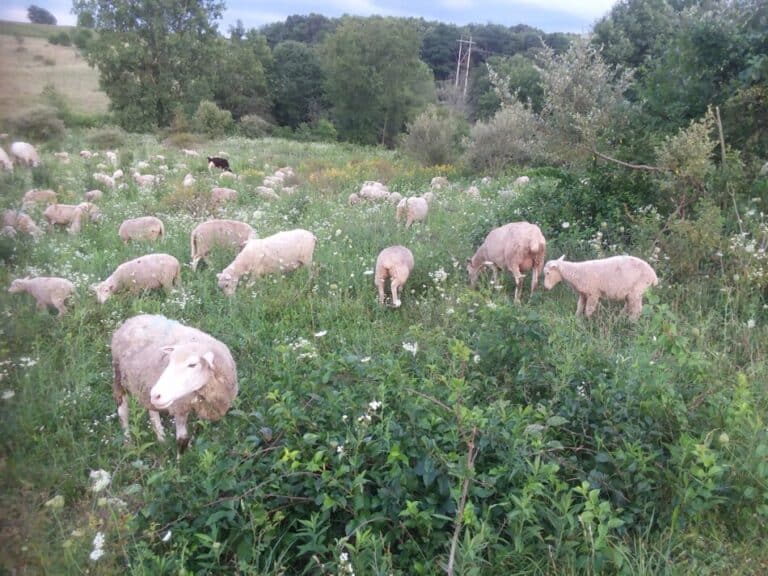Sheep Reproduction: Beginner Basics (Chart With Definitions)
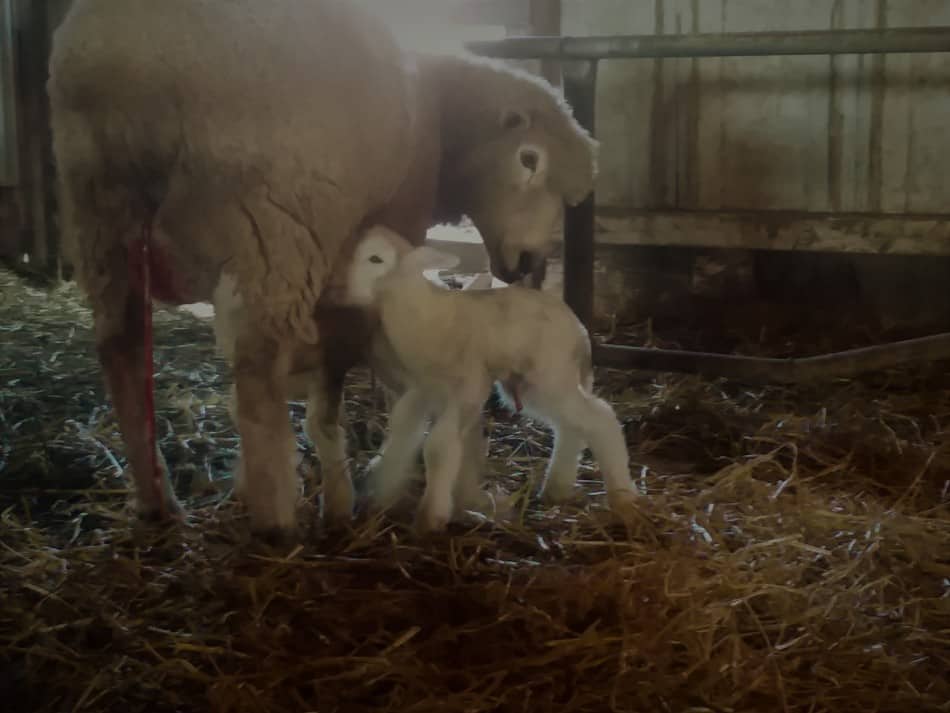
Confused when sheep people start talking sheep? Or maybe you’re looking into getting a few sheep but are having trouble finding out the basics? Look no further, I’ve got you covered!
| Term for adult female sheep | Ewe |
| Term for adult intact male sheep | Ram |
| Term for castrated male sheep (all ages) | Wether |
| Term for all sheep under one year of age | Lamb |
| Term for female lamb under one year of age | Ewe Lamb |
| Term for intact ram lamb under on year of age | Ram Lamb |
| Yearling (also called shearling) | Lamb over 1 year and under 2 |
| Number of lambs per ewe average | 1.5 lambs |
| Age of first lambing | 1-2 years old |
| Age of sexual maturity-ewe lambs | 6-8 months |
| Age of sexual maturity-ram lambs | 4.5-5 months |
| Length of heat cycle | 17 days |
| Gestation length | 5 months |
| Number of lambs a ewe can raise unassisted | 2 lambs (some can handle 3) |
| Reproductive life of a ewe | 8 years |
| Reproductive life of a ram | 8 years |
| Term for a sheep that will be sold from the flock due to under performance, both sexes | Cull |
The structure of this article is going to be almost like a dictionary, with the term then a definition and an example or two as needed.
If you’re looking for more of a “How To” click through some of my site or start here Complete Guide To Raising Sheep.
If you are looking for more of a numbers based article, read Sheep For Profit, where I show you how to figure out your budget for raising sheep in your area.
Sheep terms explained
Ewe
A ewe is an adult female sheep. Ewes can be of any age older than one year and of any breed.
When you see the big flocks of sheep, like in the western U.S. or on the sheep stations of Australia, the vast majority of the adult sheep you are seeing are ewes.
Ram
A ram is an adult intact male sheep kept for breeding purposes.
The really big sheep operations would have 1 ram per 100 or so ewes plus 1, for example: 500 ewes require 6 rams. Flocks in our area will be more like 50+ ewes per mature ram.
Wether
A castrated male sheep is called a wether. Castration is not necessary to sell male lambs, but some sheep raisers prefer to castrate.
Generally, wethers are lambs (under one year old) but not always. For most breeds of sheep, a wether is raised for meat.
The most common exception here is sheep kept for their fleeces only. Some very rare breeds of sheep have such valuable wool that the wethers are kept as fiber producers.
Actually, a wether might have a nicer fleece than a ewe, since the wool will be weakened during times of stress on the sheep, like birth (not a problem for a wether!)
Lamb
Lamb is the term for any sheep that is under one year of age. The age of a sheep is determined by the front two incisor teeth erupting through the gums.
The adult teeth are easily noticeable, since they are longer than the surrounding teeth.
When you look into a lamb’s mouth the front teeth will make a nice even curve. In a yearling’s mouth, the two teeth in the middle will be bigger.
Ewe Lamb
A female lamb is called a ewe lamb. Once she gets to be over a year, she is then referred to as a ewe.
Ram Lamb
An intact male lamb is called a ram lamb. Once he is over a year old, he is referred to as a ram.
If he is well grown for his age a ram lamb can be used as a herd sire for a small flock. He will need to be with a small group of ewes 25 at most!
Also, younger ewes, preferably ewe lambs, will be less bossy/pushy with him. Next year, he’ll be more sure of himself, as a lamb give him an easier to work with group of females.
Yearling
A yearling is a lamb that is over one year of age and under two. Usually this is a term for young ewes that are not yet moms, but since they are more than a year old are not lambs.
Some people refer to young sheep of this age as shearlings. In the U.K. sheep of this age are called hoggets. We always call them yearlings.
Lambs per ewe average
This is the number of lambs born to each ewe in the flock as an average.
Obviously, no ewes have half a lamb! This number can be a little misleading for two reasons: breed and number sold.
First off, the breed and management system play a huge roll in how many sheep are born per ewe.
A sheep that has to fend for herself in a sparse grazing situation with very little human interference will do better with just one lamb.
A ewe in an area of high fertility with predator protection can support herself plus twins.
The second aspect to remember here is that lambs born is not the same as lambs sold.
A flock with a really high birth rate that has scrawny or weak lambs that don’t make it, just has a lot of babies born.
You only get paid for lambs raised and sold!
Age at first lambing
The age at first lambing will vary by breed and management.
We shoot for the first lambing at one year of age, so a ewe lamb will have her first set of babies at around the same time she turns one year old.
For fast growing breeds being well managed for high levels of nutrition, this is doable.
For slower to mature breeds or ewe lambs receiving less nutrition than they need to grow and breed early, it will be more like two years old at first lambing.
Remember, a ewe lamb is still growing herself and will need the nutrients to support a healthy pregnancy.
If she is well grown and healthy, lambing at a year of age will work fine.
If she has been given so-so nutrition, she’ll need extra time to grow before being able to breed.
Sexual maturity of ewe lambs
Most ewe lambs will reach sexual maturity at around 6-8 months of age. This will depend greatly upon breed and nutrition.
A well grown ewe lamb will reach sexual maturity faster than a poorly fed ewe lamb.
We handle this, the high nutrition needs of ewe lambs, by pulling them out of the main flock at around 4 months of age and keeping them in a ewe lambs only flock.
This way we can be sure the ewe lambs are getting all of the feed they need to be well grown and hopefully be a mom at a year.
Sexual maturity of ram lambs
Ram lambs can fool you. They tend to reach sexual maturity sooner than you would think, around 4.5-5 months of age.
It’s a little crazy, a ram lamb can be nursing his mom one minute and trying to breed a ewe a few seconds later.
Once they start riding ewes, even if “nothing happened” they need out of there or you’ll have some surprise lambs in 5 months or so.
Length of heat cycle
The heat cycle in sheep is 17 days long. Keep track of this on the calendar, especially the day you turn in the rams for breeding.
We use ram harnesses to mark the ewes when they are bred then watch for rebreeding during the next heat cycle.
The ewes in your flock will vary when they come into heat, not every one of them will come into heat the same day.
The day she comes into heat will be spread out randomly over the 17 day time period. The second heat cycle she will be on the same schedule as the first cycle.
For example: if the ewe can in the 6th day of the first heat cycle, she’ll come in the 6th day of the second heat cycle.
When does the heat cycle start? When you start keeping track, seriously. We start keeping track of the heat cycle when we turn in the rams.
The day the rams go into the main flock for breeding season is the first day of the heat cycle.
Gestation Length
The gestation length of a sheep is 5 months. For example: if the ewe is bred on Nov. 15th she’ll have her lambs around April 15th.
Notice I wrote around, not precisely on April 15th. Five months is an easy way to estimate when you can expect lambs, but don’t wait until that day to be ready!
Get your stuff together at least one week (10 days would be better), ahead of time. Babies don’t read calendars and multiple births tend to come early!
Number raised unassisted
This is the number of lambs that a ewe can raise by herself. Most flock owners will pull off any lambs over two per ewe.
This lamb can be grafted onto another ewe, be careful here and monitor the situation if you choose this route! Or most people would bottle feed the extra babies.
We like to leave the triplet moms with all of her babies and supplement the lagging one with a bottle, if needed.
This requires a higher level of management on your part. If you are not willing to check the lambs multiple times per day, you are likely to lose the lamb.
Some ewes can handle triplets some cannot. Either way, keep track of the triplets and if you see one lagging a bit in growth do something quickly.
Reproductive life of a ewe
The reproductive life of a ewe means the years she will be a productive member of your flock. As long as she stays healthy, she should make it to 8 years of age.
How long she stays productive depends upon:
- how you care for her
- parasite load
- how well her teeth hold up.
The first two are both all you, since they are management. Keeping your ewes well cared for and with a minimal parasite load will allow your sheep to perform up to their potential.
Her teeth are a different story, there’s not a lot you can do about teeth wearing out except monitor the situation and check the teeth of any older ewe that seems to be having trouble keeping weight on.
When her teeth wearing out, she will no longer be able to eat enough to support her needs, not to mention that of her lambs! A ewe with problem teeth should be culled.
Reproductive life of ram
The reproductive life of a ram is the years he will be a productive sire for your flock.
A high quality ram should be able to work as a herd sire for around 8 years or so. Keeping the same ram for his entire life will only work if you sell all of the lambs.
In most cases, a good ram will be sold (even though he has plenty of productive years as a flock sire left in him) because you are keeping back his daughters. In this case, you need a different ram to avoid inbreeding.
Another option, to avoid inbreeding, is to section off the ewe lambs and get a different ram for them. If you are going to keep all of the sheep together, sell the ram.
A ram that is healthy and vigorous would make another small flock sheep producer an excellent flock sire. In this case, the ram is still a great ram, he just needs to be used on different ewes.
The other aspect of keeping the same ram for his entire productive life that you should consider is this: is he the best flock sire for your flock? If he is, keep him.
If he is just easy because you already own him, you are shorting yourself and limiting your potential improvement as a shepherd.
Consider that another ram more suited to your sheep/flock improvement goals may suit you and your flock better.
Cull
To cull a sheep is to pull it out of the breeding flock due to under performance.
The sheep is called a cull and pulling her out of the flock to sell her is called culling.
There are multiple reasons to cull a sheep.
Poor condition, heavy worm load compared to the rest of the flock, showing her/his age, poor feet, bad attitude, bad mothering, poorly performing lambs, etc, are a few examples of reasons to cull sheep from your flock.
Once you get going with your flock, you will figure a few things out and become a better shepherd.
You will also be less accepting of problems when you have more than a few sheep to care for.
You’ll start to figure out what is worth dealing with and what behaviors/problems are not acceptable to you, helping to clarify the culling process.
With knowledge and experience, you will learn to use culling as a tool to help improve your flock.
Sheep 201 is a wonderful sheep site, along with Sheep 101, which covers more of the basic sheep information. Definitely click around and see what you can learn, this is a great resource for anyone interested in sheep.
